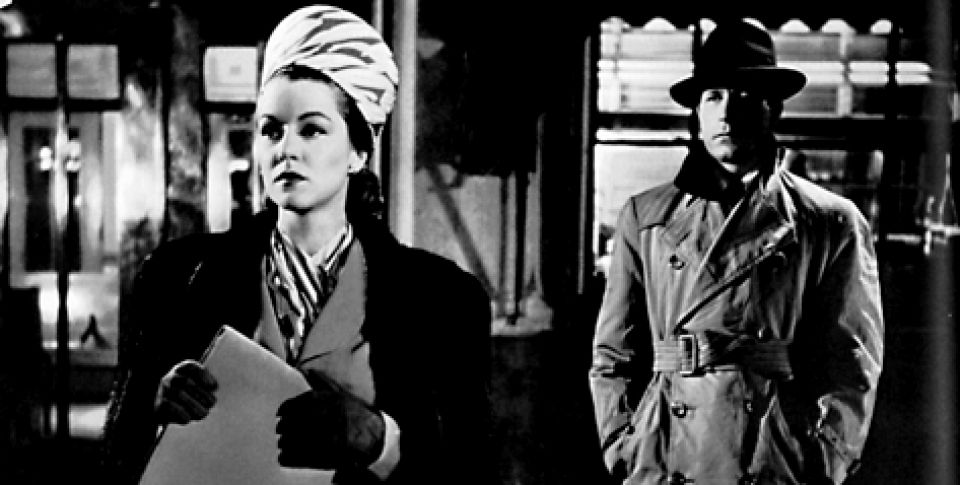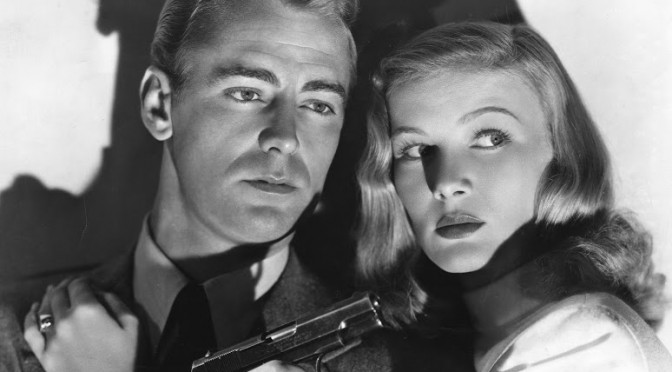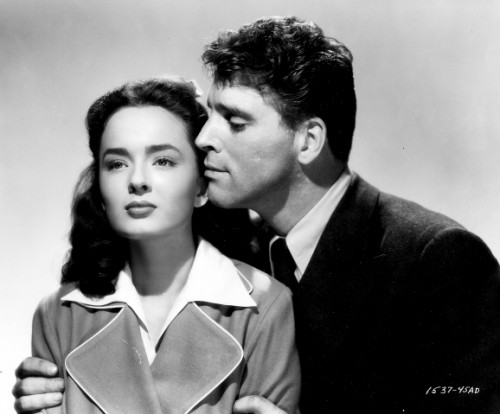The year 1947 was a notable year for that developing genre of film, later to be dubbed Film Noir. Black Film – a style of bleak film-making fostered by the horrors of the recent end of World War II. Soldiers and sailors had just returned home after seeing all types of misery and death. Women had been on their own, working, if they hadn’t also served overseas. They were now tough and independent, and in Film Noir they gave as good as they got. They may have been the femme fatale, but their fate was no better than that of their marks. A new realism was expected in the movies, reflecting the tough adjustment being made by tens of thousands of servicemen suffering from the yet to be diagnosed ailments of post traumatic stress disorder.
The film-making techniques of Film Noir themselves were also well-suited to the new realities of lower budgets at the movie studios. The foreign markets had disappeared altogether during the war, and were still soft in the post WWII war-torn economy. These techniques are classic in Noir: black & white film, B-film actors and directors, light and shadow to emphasize drama, humble interior sets and street location filming, flashbacks and voice-overs to tell part of the story, and single camera filming. Dialogue was key and always used a snappy back and forth style borrowed from pulp fiction, Raymond Chandler, and street slang. Let’s take a look at some of the best of a large crop of films noir produced in 1947.

BRUTE FORCE: Directed by Jules Dassin starring Burt Lancaster, Hume Cronyn, Yvonne de Carlo and Ann Blyth. Using a flashback technique, several prison inmates including Burt Lancaster as Joe Collins live out their days in a cell. Their sole diversion is a picture of a beautiful young woman, upon which they play out their nostalgic recollections of past sweethearts. Their flashbacks also revisit the circumstances that led each to prison, often involving betrayals. The ambitious prison captain played by Hume Cronyn is cruel and sadomasochistic, tempered only slightly by the prison doctor and warden. “Brute force” is what the doctor, played by Art Smith, calls prison Captain Munsey.The cell-mates’ miserable lives are made worse by the threat of stool pigeons in their midst. Hard labor assignments are given them in the prison drain pipes where they plan a prison breakout. Only a stoolie passes on the info, and a shootout results, and then a bigger prison breakout attempt.The doctor’s parting words say it all, “Nobody escapes. Nobody ever really escapes.” In this case that goes for the prison captain too.
The flashback trope of film noir works effectively here and serves as the light in contrast to the dark shadows of betrayal, fate. and prison life. The very early films of Burt Lancaster showed him as a perfect film noir actor. There was no ham or bravado, just the stoicism needed for the role. Director Jules Dassin was blacklisted in Hollywood so Daryl Zanuck at Fox sent him to London to make that masterpiece of Noir, Night and the City ((1950). He then moved to France where he made another Noir masterpiece, Rififi (1954).

KISS OF DEATH: Directed by Henry Hathaway, starring Victor Mature, Coleen Gray, Richard Widmark, Brian Donlevy and Karl Malden. This Fox film was based on a story by Eleazar Lipsky, with screenplay by Ben Hecht and Charles Lederer. It was filmed on location in New York in several places including The Tombs, the Bronx County jail, the downtown Criminal Courts Building, the Louisa M. Alcott house on Sullivan Street, the Chrysler Building and the Hotel Marguery. Other locations included Sing Sing Prison and Astoria, NY, and Fort Lee, NJ, all sites original to the story. The story itself centers on the character played by Victor Mature, a jewel thief and his gang who get nabbed. He is pressed to turn evidence on the others but refuses, under the mistaken assumption that his lawyer will take care of his wife and young daughters. With a long prison term and a tragic fate for his family, he later agrees to work with the D.A. and is released on parole. His former baby-sitter played by Coleen Gray tells him what has happened and they begin a relationship. Her character uses voice-over to tell parts of the story. His goal is to get a sadistic drug user named Udo, played by Richard Widmark.
One scene in the movie made Richard Widmark famous, where he confronts Ma Rizzo, a gangster’s mother who is in a wheel chair, and pushes her down the stairs. The rest of the film was who was going to kill or capture whom. The Joseph Breen controlled Production Code Administration had problems with a lot of the script: drug-use and the Law’s reliance on stoolies to get their job done. The wheelchair-down-the-stairs scene was not well liked either. Richard Widmark in his first film had made his name. He was also nominated for a Best Supporting Actor.

NIGHTMARE ALLEY: Directed by Edmund Goulding, starring Tyrone Power, Coleen Gray, Joan Blondell, Helen Walker, and Mike Mazurki. This Fox film was an unusual Noir, mainly due to its carnival setting and its fake spiritualist con game. It was also an unusual role for Tyrone Power, one he wanted desperately to play in order do get away from the handsome cavalier roles he was always portraying. Daryl Zanuck did not like the idea, however, of him playing the role of Stan Carlisle in the movie,. Carlisle was a smart and ambitious carnival worker, looking for an angle. So he angled himself into the carnival tricks of Zeena (Joan Blundell) and Pete the alcoholic. Only he draws a bad Tarot card and Carlisle’s manipulative spiritualist con spirals up and then down, as he becomes an alcoholic and eventually a carnival geek, the lowest of the low among the travelling folk. All of this after he himself was manipulated out of all the money he cleverly swindled from other people in his spiritualist con game. His degradation is superbly acted by Tyrone Power, who was so cocky at the beginning of the film.
The script was based on William Lindsay Gresham’s pessimistic novel. The Production Code was not a fan of the resulting script, and the sexual relationships had to be eliminated. An even worse end for Power’s character was changed by Zanuck. Nonetheless, Tyrone Power’s fans did not like this role for their idol, and the film flopped. Today it is considered a cult classic and a Noir favorite.

POSSESSED: Directed by Curtis Bernhardt, starring Joan Crawford, Van Heflin, Raymond Massey, and Geraldine Brooks, Warner Brothers. This disorienting Noir classic begins with Joan Crawford as the deeply disturbed Louise Howell as she is found wandering the nighttime streets of L.A. and is taken to a psychiatric hospital (back in the day when people cared and there were facilities to treat such people). Joan/Louise tells the doctor her story, a complex tale of reality and psychological fantasy caused by the death of her nursing charge, the wife of David Graham. Mrs. Graham’s daughter’s voice spooks her into thinking she is still alive, with jealous undertones implying a possible affair. The man Louise really loves, David Sutton, played by Van Heflin, always seems to be detached. Louise decides to quit but Dean asks her to marry him. They wed, but her past always interferes with her happiness. She imagines the ghost of David’s wife and believes that she was the one that killed her. She and Dean run into David, who is dating Dean’s daughter. They become engaged. David was the one she always loved and she becomes more and more unbalanced. She tells Carol that David really loved her. Dean tells her she needs to see a psychiatrist. She goes to David who tells her he will tell Dean all about their former affair. That’s when the pistol blazes.
Possessed is one of the few Noirs told from the woman’s point of view. It also won Joan Crawford an Academy Award nomination for Best Actress.
BORN TO KILL: Directed by Robert Wise starring Lawrence Tierney, Clare Trevor, Audrey Long, Walter Slezak, Elisha Cook Jr. and Esther Howard. Produced at RKO. Eddie Muller called this film noir, “The most perverse film of 1947.” Joseph Breen of the PCA described this film as “the kind of story which ought not to be made because it is a story of gross lust and shocking brutality and ruthlessness.” The film was based on the book, Deadlier Than the Male, by James Gunn. RKO had to tone down some of the violence to get PCA approval. Still, the movie opens up with two cold-blooded murders committed by Sam Wilde (Lawrence Tierney), and when Helen Brent (Clare Trevor) returns to the boarding house of Mrs Kraft, and sees the bodies, she cooly flees, taking a train to San Francisco from Reno where she was there to get a divorce. Taking the same trip is Sam, who strikes up a flirtation. They had met briefly in Reno’s casino before she returned to see the murder victims. She is uninterested, but is equal parts attracted and repelled by him. In San Francisco, he comes to visit her at her rich half-sister’s house, where Helen’s fiance is present. To Helen’s distress, Sam courts Georgia, her rich half-sister, whom she is jealous of. Soon the two marry, but Sam shows he’s really interested in Helen, seeing in her a kindred spirit. Meanwhile Mrs. Kraft hires a private detective to investigate the murders, and he finds his way into the mansion during the wedding, and finds evidence that Sam committed the murders. He relays this to Mrs Kraft, who Helen then visits and threatens her by saying Sam would kill her if she conveyed that information to the police. Mrs Kraft sees the cool manipulation behind the threat, and says, “You’re the coldest iceberg of a woman I ever saw. I wouldn’t trade places with you if they sliced me into little pieces.” And soon enough Sam’s friend does try to slice her up. And most everyone gets it one way or the other in this movie. Eddie Muller’s description pretty much summed it up. It’s a pretty black film noir.

HIGH WALL: Directed by Curtis Bernhardt, starring Robert Taylor, Audrey Totter, Herbert Marshall, Dorothy Patrick, and H.B. Warner. MGM. This little known Noir is another directed by the German Curtis Bernhardt, who directed Possessed, above. This has a somewhat similar plot as The Blue Dahlia, where U.S serviceman, Steven Kenet played by Robert Taylor, also a pilot, returns to a wife who is having an affair with her boss. Soon after his return he is arrested after an accident where he tries to kill himself – with her dead body in the trunk of his car. Only now he remembers nothing. He is placed in a psychiatric hospital where a blood clot is found in his brain. Surgery is called for to remove it but he refuses the surgery. The Assistant D..A. suspects that Kenet is angling for an innocent plea based on a mental defect. Dr. Ann Larison played by Audrey Totter convinces him that he should have the surgery in order to keep his son from going to an orphanage. The surgery cures him but his memory of the event does not come back. Only after she gives him sodium pentothal does he recall what happened, and who the real guilty party was. By then he and Ann were falling for each other. And when someone stepped forward with some evidence but was then murdered, they hatched a plan. Only he is still confined to the psychiatric hospital, or can he get out to prove himself?
This is a stylish Noir with deep black and white cinematography and fine acting. It deserves better recognition.

T MEN: Directed by Anthony Mann, starring Dennis O’Keefe, June Lockhart, Mary Meade, Wally Ford and Alfred Ryder. The movie was shot in a documentary style about the Treasury Men and the crooks they were after. Location shooting took place in several places in Los Angeles and Detroit, Washington, New York, and San Pedro, including the L.A. locales of the Farmer’s Market, and the former Pacific Ocean Park. The story is about a couple of Treasury officers infiltrating a counterfeiting gang in L.A. Their cover is that of bank robbers – but their mission is dangerous, and one of them will not come out alive. The cinema verite style is perfect for the story that was ripped right out of the files of the Treasury Department.
OUT OF THE PAST: Directed by Jacques Tourneur, starring Robert Mitchum, Jane Greer, Kirk Douglas, Rhonda Fleming and Virginia Huston. RKO. This classic Noir is also my favorite, an outstanding mixture of talent, story, cinematography, and film noir filmmaking. The story opens with Robert Mitchum as Jeff Bailey enjoying a peaceful life in California’s Sierra Mountains, working at a gas station when two former shady acquaintances from out of his past drive up. In a film noir movie that’s never a good sign. They want him to see a former client from his P.I. days, and he agrees to go. This prompts him to tell his girlfriend Ann about his past before he goes. Kirk Douglas as Whit Sterling has a new P.I. job for him for good money: find the girlfriend that shot Whit and then ran off with $40,000 of his money. Jeff finds her after several days of loitering in the cantinas of Acapulco. And after several rounds of sharp cat-and-mouse dialogue and some flirting, Jeff falls in love and into the clutches of the doe-eyed beauty and femme fatale Jane Greer/Kathie Moffat. This was made easier by her protests of innocence. But Whit trusts no one and shows up in Acapulco.. Luckily they were not spied together, and Jeff and Kathie manage their escape. They live together for a while, but fate always lingers in film noir, and a blackmailer spots them and trails them to a cabin in the woods.. As the men fight it out in the chiaroscuro lighting, Kathie looks on with delight, waiting for the right moment to shoot and kill the blackmailer, then take off with the $40,000 she had all along. From there she ends up back in the arms of Whit Sterling, and now Jeff Bailey is the sucker, having to pay off debts to Whit by doing lousy jobs that lead into a downward spiral of bad fortune for all.

The year of 1947 had many more Noir films of merit. The entire year had many excellent films , blogged about in the 1947 Blogathon, hosted by ShadowsandSatin and Speakeasy
Views: 849











